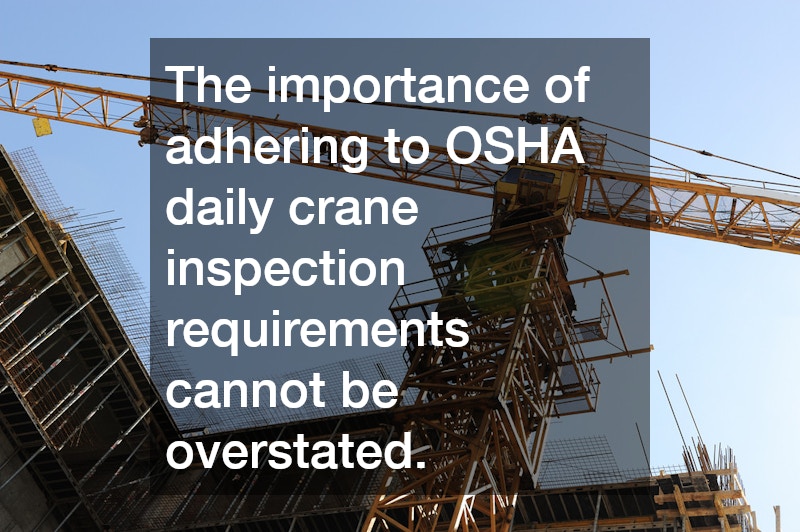
In the construction industry, ensuring the safety of workers and the integrity of operations must be taken seriously, especially when dealing with heavy machinery such as cranes. The importance of adhering to OSHA daily crane inspection requirements cannot be overstated. These guidelines are designed to prevent accidents and protect lives. Regular hoist inspections, performed by a qualified crane inspector, are essential for identifying potential hazards and ensuring that all equipment operates safely and efficiently.

A daily crane inspection checklist is handy in this process, outlining key elements that must be checked before lifting operations begin. This checklist helps crews systematically assess the crane’s condition, including its structural integrity, functionality of controls, and presence of wear or damage. Keeping detailed records of these inspections complies with crane standards and significantly reduces the risk of equipment failure during lifting operations.
Furthermore, staying informed about crane standards established by the Occupational Safety Health Administration (OSHA) equips construction professionals with the necessary knowledge to ensure equipment safety. By prioritizing thorough inspections and adhering to regulatory requirements, construction teams can promote a culture of safety that benefits everyone on-site. Emphasizing the significance of these inspection protocols will ultimately lead to a more secure work environment, minimizing risks and increasing productivity.

Working in the construction industry means it’s important to stay safe, regardless of what work is going on. With all the different construction equipment out there, it’s possible to accidentally hurt oneself due to not being familiar with how something works. Over 30% of all injuries with heavy equipment is due to improper use of the machines. Taking the time to observe basic safety rules and working closely only with what you know is important. Learn more about how to keep safe when working with equipment.
Ensure Equipment is Properly Maintained
Although accidents can happen at any time, they occur even more than usual when the equipment is not being maintained. This means that heavy equipment parts may have rust, aren’t turned up, or something is loose. This leads to further problems and can result in accidents at work. Always have equipment checked. If something is unsteady or doesn’t look safe, don’t use it. It’s important to stay safe and prevent problems where one or several workers could be injured simply because something wasn’t tuned up or checked prior to being brought out to the construction site.
Keep Plenty of Distance
Keeping a proper distance between yourself and construction equipment sounds obvious to most folks, but it’s how accidents commonly occur. OSHA mandates that workers stay at least 10 feet away from the overhead cutoff when dealing with construction equipment that is heavy. Workers have been injured and even died when they didn’t keep the proper amount of distance from equipment. These problems are preventable. Make sure you’re always aware of your surroundings and know what’s going on. Avoid being under heavy machinery. If you cannot operate the machinery for any reason, make your supervisor aware. It’s better to prevent an accident in any way possible than have something happen because you’re not feeling good.
Report Any Possible Issues That Could Impact Workplace Safety
Anyone handling construction equipment should be aware that it’s important to report unsafe people, machines, or conditions in order to keep everyone safe. Doing so might be difficult for some folks, but it’s better to prevent an accident from happening which could cost a lot of money for the company (or even an individual), slow down a project, and cause people to lose time. Reporting unsafe conditions should be seen as something that is a way of life for anyone who works in the construction industry and wants to stay safe.
There are over 7.7 workers who are employed in the construction industry. Anyone who does this work knows how difficult it is, and the importance of staying safe or facing the consequences. Make sure to keep distance when dealing with heavy machinery, and report unsafe conditions that could make an accident worse. If there is equipment that hasn’t been properly maintained and could cause an accident, don’t use it. Doing these simple steps makes the workplace safer for everyone, and saves money for the company and employees alike.